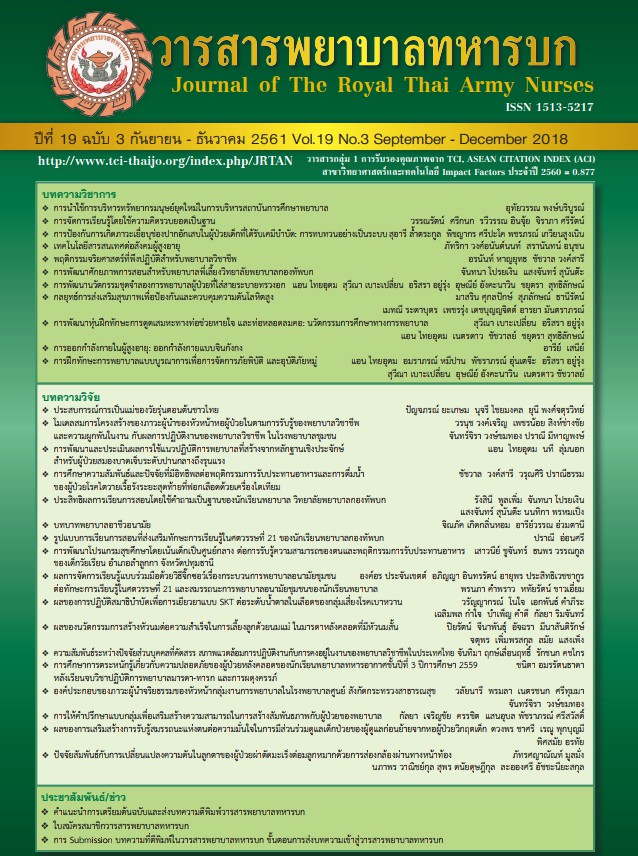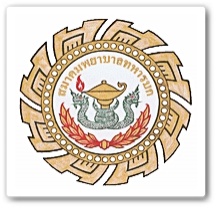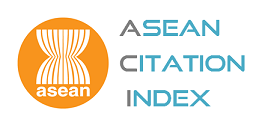The Structural Equation Model of Leadership of In-Patient Unit Head Nurses as Perceived by Professional Nurses, Nurses’ Work Engagement, and Job Performance of Professional Nurses in Community Hospitals
คำสำคัญ:
ผลการปฏิบัติงานพยาบาลวิชาชีพ, ภาวะผู้นำ, ความผูกพันในงาน, หัวหน้าหอผู้ป่วย, โรงพยาบาลชุมชนบทคัดย่อ
การวิจัยครั้งนี้เป็นการวิจัยเชิงวิเคราะห์ มีวัตถุประสงค์เพื่อวิเคราะห์โมเดลสมการเชิงโครงสร้างของผลการปฏิบัติงานของ พยาบาลวิชาชีพประจำหอผู้ป่วย โรงพยาบาลชุมชน กลุ่มตัวอย่างเป็นพยาบาลวิชาชีพ สุ่มตัวอย่างตามสัดส่วนแต่ละชั้นภูมิ จำนวน 314 คน เครื่องมือวิจัยเป็นแบบสอบถาม 3 ส่วน ได้แก่ แบบสอบถามภาวะผู้นำ ความผูกพันในงาน และผลการปฏิบัติงานของ พยาบาลวิชาชีพ หาระดับความเชื่อมั่นด้วยค่าสัมประสิทธิ์แอลฟาของครอนบาค เท่ากับ 0.94, 0.87 และ 0.96 ตามลำดับ วิเคราะห์ ข้อมูลด้วยสถิติเชิงพรรณนาและสถิติวิเคราะห์โมเดลสมการโครงสร้าง ผลจากการวิจัย พบว่า ภาวะผู้นำมีอิทธิพลทางตรงกับความผูกพันในงาน (β = .53, p<.001) ภาวะผู้นำและความผูกพัน ในงานมีอิทธิพลทางตรงกับผลการปฏิบัติงานของพยาบาลวิชาชีพ (β = .14, .48, p<.05, <.001) โมเดลเชิงโครงสร้างของผลการ ปฏิบัติงานของพยาบาลวิชาชีพมีความสอดคล้องกับข้อมูลเชิงประจักษ์ (Chi-square = 8.969, df = 8, Probability level = 0.345, CMIN/DF = 1.121, GFI = 0.992, AGFI = 0.972, SRMR = 0.006, RMSEA = 0.020) โดยสามารถอธิบายความแปรปรวนของ ผลการปฏิบัติงานของพยาบาลวิชาชีพได้ร้อยละ 32 (R2 = .32) จากข้อค้นพบการวิจัยครั้งนี้ แสดงชัดว่าผู้บริหารทางการพยาบาลควรมุ่งเน้นให้มีหลักสูตรหรือมีนโยบายในองค์กรให้มี การเตรียมความพร้อมและพัฒนาภาวะผู้นำของหัวหน้าหอผู้ป่วย ให้มีทั้งภาวะผู้นำการเปลี่ยนแปลงและภาวะผู้นำการปฏิบัติ เพื่อ ส่งเสริมให้พยาบาลวิชาชีพเกิดความผูกพันในงานอันจะส่งผลในทางบวกต่อผลการปฏิบัติงานของพยาบาลวิชาชีพ
Downloads
References
2. Office of the Civil Service Commission. Civil service act B.E. 2008. 2008. (in Thai)
3. Khunthar A. The impacts and solutions to nursing workforce shortage in Thailand. Journal of Nursing Science. 2014; 32(1):81-90. (in Thai)
4. Bogaert PV, Peremans L, Heusden DV, Verspuy M, Kureckova V, Cruys ZV, Franck E. Predictors of burnout, work engagement and nurse reported job outcomes and quality of care: a mixed method study. BMC Nursing. 2017; 18:1-14.
5. Rogers AE, Hwang W-T, Scott LD, Aiken LH, Dinges DF. The working hours of hospital staff nurses and patient safety. Health affairs. 2004; 23(4):
202-212.
6. Jyoti J, Bhau S. Impact of transformational leadership on job performance: Mediating role of Leader-member exchange and relational identification. SAGE Open. 2015; 5(4):1-13. DOI: 2158244015612518.
7. Gordon HJ, Demerouti E, Bipp T, Le Blanc PM. The job demands and resources decision making (JD-R-DM) model. European Journal of Work
and Organizational Psychology. 2015; 24(1): 44-58. DOI: 1359432X.2013.842901.
8. Bass BM. Bass and Stogdill’s handbook of leadership: Theory, research and managerial applications. New York: Free Press. 1990.
9. Schaufeli WB, Bakker AB, Salanova M. The measurement of work engagement with a short questionnaire. Educational and Psychological Measurement. 2006; 66:701-716.
10. Greenslade JH, Jimmieson NL. Distinguishing between task and contextual performance for nurses: development of a job performance scale. Journal of Advanced Nursing. 2007; 58(6):602-611.
11. Krejcie RV, Morgan DW. Determining sample size for research activities. Educational and psychological measurement. 1970; 30(3): 607-610.
12. Meehanpong P, Luangamornlert S, Changmai S. A causal model of patient unit performance in general hospital under ministry of public health. Journal of The Royal Thai Army Nurses. 2015; 16:78-86. (in Thai)
13. Kittimanont H. A causal model of health professional personnel performances in the university hospitals in Thailand (Doctoral dissertation). Hospital management, Christian University. 2014. (in Thai)
14. Hair J, Black W, Babin B, Anderson R. Multivariate data analysis. (7thed.). Pearson Prentice Hall. 2010.
15. Salanova M, Lorente L, Chambel MJ, Martınez IM. Linking transformational leadership to nurses’ extra-role performance: the mediating role of self-efficacy and work engagement. Journal of Advanced Nursing. 2011; 67:2256-2266.
16. Devi VR, Narayanamma PL. Impact of leadership style on employee engagement. Pacific Business Review International. 2016; 1(1):91-98.
17. Saks AM. Antecedents and consequences of employee engagement. Journal of Managerial Psychology. 2006; 21(7): 600-616.
18. Jankingthong K, Rukkhum S. Factors affecting job performance: A review of literature. Silpakorn University Journal of Social Sciences, Humanities, and Arts. 2012; 12:115-127.
19. Matula P, Uon VA. Causal relationship model work engagement affecting organizational citizenship behavior and job performance of professional nursing. Middle-East Journal of Scientific Research. 2016; 24:1600-1605. (in Thai)
20. Rattikarnsuka J, Oumtanee A. Nursing management of head nurses receiving the outstanding award. Journal of The Royal Thai Army Nurses. 2014; 16:179-186. (in Thai)
21. Chaleoykitti S, Kamprow P, Promdet S. Patient safety and quality of nursing service. Journal of The Royal Thai Army Nurses. 2014; 15:66-70.
(in Thai)
Downloads
เผยแพร่แล้ว
How to Cite
ฉบับ
บท
License
บทความหรือข้อคิดเห็นใดใดที่ปรากฏในวารสารพยาบาลทหารบกเป็นวรรณกรรมของผู้เขียน ซึ่งบรรณาธิการหรือสมาคมพยาบาลทหารบก ไม่จำเป็นต้องเห็นด้วย
บทความที่ได้รับการตีพิมพ์เป็นลิขสิทธิ์ของวารสารพยาบาลทหารบก
The ideas and opinions expressed in the Journal of The Royal Thai Army Nurses are those of the authors and not necessarily those
of the editor or Royal Thai Army Nurses Association.






